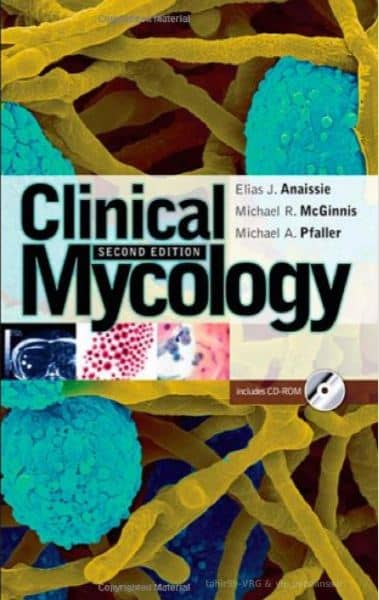‘Medical Mycology’ PDF Quick download link is given at the bottom of this article. You can see the PDF demo, size of the PDF, page numbers, and direct download Free PDF of ‘Clinical Mycology ‘ using the download button.
Clinical Mycology PDF Free Download

The Epidemiology Of Fungal Infections
Fungal infections may be divided into two categories: nosocomial and community-associated.
Nosocomial fungal infections are defined as those acquired in a healthcare setting and are almost always opportunistic mycoses.
In contrast, community-associated fungal infections include not only opportunistic mycoses but also endemic mycoses,
for which susceptibility to the infection is acquired by living in a geographic area constituting the natural habitat of a pathogenic fungus and possessing risk factors that are predisposing.
Over the past two and a half decades, the incidence of both nosocomial and community-associated fungal infections has increased dramatically.
An analysis of trends in infectious disease mortality in the United States found that fungal infections had risen from the tenth to the seventh most common cause of infectious disease-related mortality between 1980 and 1997.1
Numerous factors have contributed to the increase in fungal infections, most notably a growing population of immunosuppressed or immunocompromised patients whose mechanisms of host defense have been impaired by primary disease states (e.g., AIDS, cancer),
a mobile and aging population with an increased prevalence of chronic medical conditions, and the use of new and aggressive medical and surgical therapeutic strategies,
including broad-spectrum antibiotics, cytotoxic chemotherapies, and organ transplantation.
Nosocomial fungal infections Increasing incidence and mortality
For the past two decades, hospitals have been experiencing increasing problems with nosocomial fungal infections.
2-5 A recent study of the epidemiology of sepsis found that the annual number of cases of sepsis caused by fungal organisms in the United States increased by 207% between 1979 and 2000.
In the Surveillance and Control of Pathogens of Epidemiological Importance Study, a 49-center study of 24,179 nosocomial bloodstream infections recorded between 1995 and 2002, 9.5% of the infections were fungal in origin. Candida spp.
were the fourth leading cause of nosocomial bloodstream infections, surpassed only by staphylococci and enterococci (Table 1-1).
infections with different strains of an organism may suggest that the patient is predisposed to that particular infection as a result of specific exposures or host defects, whereas recovery of the same strain on multiple occasions suggests a relapsing infection, possibly due to a residual focus such as an indwelling catheter or persistent colonization.
64 ’ 65 Likewise, determination of DNA fingerprints of sequential isolates from patients undergoing antifungal therapy has been useful in demonstrating the potential for the development of antifungal resistance in previously susceptible strains and for detecting the substitution of a more resistant strain for a more susceptible strain in the face of intense antimicrobial pressure.
DNA fingerprinting of fungal pathogens may be accomplished with a variety of different techniques (see Table 1-11). In almost all cases, DNA fingerprinting methods involve comparisons of patterns that are assumed to reflect genetic
relatedness and are generated by some form of electrophoresis or DNA sequencing.
To be useful as an epidemiologic typing method, a DNA fingerprinting system must effectively distinguish between genetically unrelated strains, be capable of identifying the same strain in separate samples, and reflect genetic relatedness or unrelatedness (genetic distance) among strains or species.
64 Although the ability of most of the DNA fingerprinting methods listed in Table 1-11 to measure genetic distance has not been established, qualitative analysis of the various DNA profiles has been useful in studies of several nosocomial fungal pathogens. 64
One of the most recent developments in typing of the infectious fungi is multilocus sequence typing (MLST).
This methodology was developed for bacterial population genetics and involves the amplification and sequencing of small portions of a number of housekeeping genes in search of stable sequence variations.
66 ’ 67 MLST allows for universal protocol development and strain archiving in large data sets, and eliminates interlaboratory variation, as long as a good sequencing reaction can be obtained.
The single caveat to this protocol is that it may be cost prohibitive to laboratories without access to inexpensive sequencing.
MLST protocols have been developed for C. albicans , 68 ’ 69 C. glabrata , 70 C. tropicalis , 71 C. krusei 7 2 Cryptococcus neoformans , 73 and Fusarium oxysporum. 74 In addition, there is an online database listed for A.
| Author | – |
| Language | English |
| No. of Pages | 674 |
| PDF Size | 93.9 MB |
| Category | Astrology |
Also Read: Medical Mycology PDF
Clinical Mycology Book PDF Free Download
